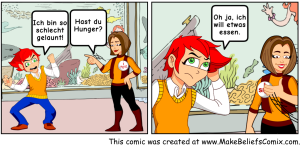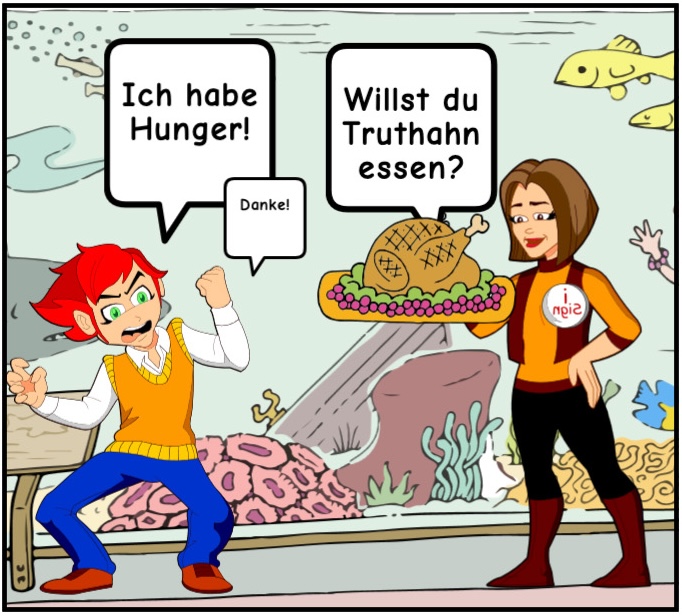6.10 Hunger haben und Essensvielfalt

Servus!
Zum Aufwärmen machen wir unseren Tagesminiplausch und eine Wiederholung.
Wiederholung
In the previous lesson, you learned how to talk about how often you have Nachtisch (dessert), ask others about their Nachtisch preferences, and talk about your Nachtisch preferences. Let’s review what you have learned.
Jetzt bist du dran!
Lektionsüberblick
In Lektionen 6.6 and 6.8, we saw some examples of typical warm and cold meals in German-speaking countries. As you can imagine, those examples are not representative of all Austrians, Germans, Swiss, etc. Austria has always be highly multicultural due to the Austro-Hungarian Empire and there is a wide variety of cuisines there. This lesson will present you with some of this variety and encourage you to investigate more on your own. In the end, you will be able to 1) ask someone if they are hungry and thirsty, 2) talk about the features of cultural cuisines, and 3) ask someone what kinds of food they want to eat.
Was weißt du schon?
| Noch nicht start klar?
Du kannst immer auf die gleiche 1010-Lektion zurückgreifen! |
Not confident about starting this lesson?
You can always review the same Lektion from 1010. |
1) Hast du Hunger? Hast du Durst?
You may remember how to stay that you are hungry or thirsty. (If not, be sure to review!) Now let’s practice asking whether your friend is hungry or thirsty. Read and listen to the comics below.


Let’s practice!
Jetzt bist du dran!
2) die Vielfalt der Küchen (the variety of cuisines)
The melting pot of the US has already brought many kinds of foods together that are considered American foods. What if you want to specify that there is a certain kind of food you want to eat? Read through the following presentation for a small number of cuisines.
Want to be able to talk about more kinds cuisines? Check out the menus on Lieferando.de.
Jetzt bist du dran!
Das österreichische Fastfood im Blickpunt
Österreich ist nicht das einzige Land mit vielen Fast-Food-Restaurants. Neben den üblichen McDonald’s-, Burger King- und KFC-Restaurants gibt es in Österreich noch weitere Fast-Food-Restaurants:
Austria is not unique in that it has its share of fast-food restaurants. Aside from the standard McDonald’s, Burger King, and KFC, here are some other fast-food places you might see in Austria:
-
Le Burger – A growing burger franchise based in Vienna.
-
Nordsee – A seafood-focused fast-food chain, originally from Germany but also popular in Austria.
-
Wienerwald – Known for its chicken dishes, originally German but has locations in Austria
Kleiner Hinweis
Once a meal has been served, Germans generally wish each other Bon Appetit – but in German!
| An Guata! | If you are in Voralberg Austria. |
| Guten Appetit! | |
| Laß es dir schmecken! | If you did the cooking and you are eating with one other person. |
| Laßt es euch schmecken! | If you did the cooking and you are eating with more than one other person. |
3) Was willst du essen/trinken? Willst du etwas essen/trinken?
Look at the comic again. Do you understand what the woman is asking?

There are different ways you can ask whether your friend wants to eat or drink something.
| Was willst du essen? | What do you want to eat? | Was willst du trinken? | What do you want to drink? |
| Willst du etwas essen? | Do you want to eat something? | Willst du etwas trinken? | Do you want to drink something? |
| Willst du [Truthahn] essen? | Do you want to eat [turkey]? | Willst du [eine Cola] essen? | Do you want to drink [a soda]? |
Let’s practice!
Jetzt bist du dran!
Zum Schluß

*As you conclude this lesson, don’t forget to check Canvas!*

Media Attributions
- 6.10 hast du hunger_make-beliefs-comix © This comic strip was generated at http://www.MakeBeliefsComix.com. Used by permission of author and site creator Bill Zimmerman.
- 6.10_hast du durst make-beliefs-comix © This comic strip was generated at http://www.MakeBeliefsComix.com. Used by permission of author and site creator Bill Zimmerman.
- Private:

